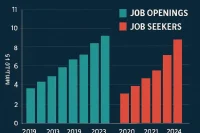Microsoft has provided reassurance to its employees over a full return to the office.
According to recent reports, the tech giant will not be following in Amazon’s footsteps by imposing a rigid RTO policy, as long as productivity remains steady.
Flexibility Remains at Microsoft
Microsoft currently allows employees to work remotely. Many staff members, particularly new hires are promised the flexibility of working from home at least half the week.
However, while this remote-working arrangement has become a norm, it is not a permanent fixture.
According to sources Scott Guthrie, Microsoft’s Executive Vice President of Cloud and AI, recently assured his team that the company does not plan to introduce a strict RTO mandate unless a noticeable drop in productivity occurs.
This message was directed at Guthrie’s team, which includes the Azure cloud division, a key component of Microsoft’s business.
While the company’s work-from-home policies have been embraced by many employees, it is clear that this flexibility hinges on the productivity of the workforce.
No Immediate Changes on the Horizon
Microsoft has been cautious in its approach to managing the post-pandemic work environment. According to statements the company’s official policies on remote work have not changed.
As of now, employees can continue to enjoy the current hybrid setup, without the looming threat of mandatory in-office attendance.
However, questions remain regarding how Microsoft measures productivity and what benchmarks might trigger a policy change.
Sources have reached out to the company to gain clarity on the specific metrics that would be used to evaluate employee performance and whether this evaluation process would be transparent to staff members.
Amazon’s Strict RTO Policy Sparks Backlash
Microsoft’s measured approach contrasts sharply with the controversial return-to-office stance adopted by Amazon.
Earlier this year, Amazon CEO Andy Jassy announced employees must return to the office. This move has has ignited widespread dissatisfaction among Amazon’s workforce.
Employees have voiced their frustration over the potential loss of flexibility. Many now face the prospect of long, exhausting commutes that were eliminated during the remote work era.
Jassy’s firm stance on RTO has sparked a phenomenon known as “rage applying.” This is where employees look for new jobs out of frustration with rigid policies.
Many Amazon employees, especially those hired with the understanding that they could work remotely permanently, now find themselves reconsidering their career options.
A survey by job review site Blind revealed 73 percent of verified Amazon workers are contemplating quitting due to the RTO mandate.
This trend has sparked predictions Jassy, along with other executives enforcing similar policies, may eventually be forced to reconsider their positions as worker discontent grows.
Need Career Advice? Get employment skills advice at all levels of your career
The Debate Over Remote Work: Differing Executive Views
Amazon’s decision is not an isolated case in the tech world.
Elon Musk, another high-profile tech leader, has also been vocal about his opposition to remote work.
In June 2022, Musk eliminated hybrid and remote work arrangements at Tesla. He claimed employees working remotely were “pretending to work.” His comments were aimed specifically at white-collar employees, whom he criticized for wanting the flexibility that factory workers do not have.
Musk’s comments, which drew comparisons between office workers and blue-collar staff, have exacerbated tensions between different segments of the workforce. He argued Tesla’s factory workers were unfairly burdened compared to office workers who were able to work from home.
White-Collar vs. Blue-Collar Tensions
Musk’s views on RTO highlight the growing divide between white-collar employees and their blue-collar counterparts.
This tension has been reflected in labor movements beyond the tech industry, most notably in the recent strike by US dockworkers along the Eastern Seaboard and Gulf Coast.
For the first time since 1977, dockworkers have gone on strike, demanding fair compensation for their efforts during the pandemic.
The strike is estimated to cost the US economy as much as $4.5 billion a day.
Harold Daggett, president of the International Longshoremen’s Association (ILA), stated dockworkers continued to work through the pandemic while many white-collar employees were able to stay home.
Daggett emphasized the need for fair recognition of these workers’ sacrifices, saying:
“Not my men; they died out there with the virus… Well, I want to be compensated for that.”
What Lies Ahead for Microsoft?
Microsoft’s decision to maintain its flexible work policies, at least for now, is a relief for its employees. However, the message from Scott Guthrie serves as a reminder that the company’s stance could shift if productivity falters.
As tech companies navigate the evolving work landscape, employees are keenly aware that nothing is set in stone.
While Amazon and Tesla are examples of firms adopting stricter policies, Microsoft seems committed to a more balanced approach, respecting the productivity and well-being of its workforce. The long-term future of hybrid work at Microsoft may ultimately depend on how well employees continue to perform in a remote environment.
In an era where remote work remains a critical factor for job satisfaction, companies like Microsoft face the ongoing challenge of balancing flexibility with performance expectations.
For now, employees at the software giant can rest easy, but the ongoing debate over RTO policies will likely continue to shape the future of work in the tech industry.




